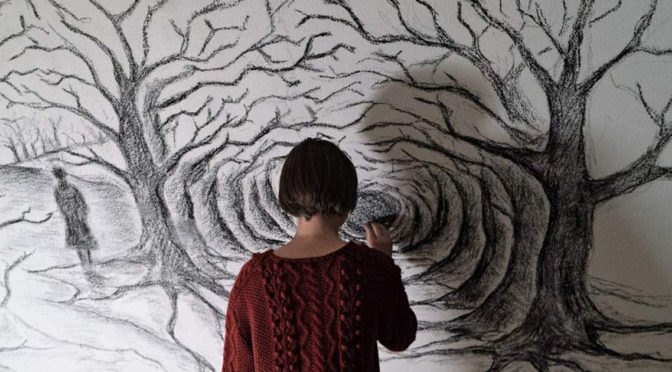In a village in Sicily, Luna attempts to woo her classmate Giuseppe. After school, they share their afternoon in a dozen teenage adventures. At the end, she gives him a love letter and they share a kiss. But this is no charmed life. Giuseppe is the son of a Mafioso – and after Luna kisses him, he disappears off the face of the earth.
SICILIAN GHOST STORY is a modern-day fairytale by co-director/writer team Fabio Grassadonia and Antonio Piazza (previous collaborations include SALVO). The film takes a dual viewpoint, following each of the children from the point of their separation. Luna (Julia Jedlikowska) searches for Giuseppe (Gaetano Fernandez) and becomes increasingly angered as the adults in her world are revealed to be blind, indifferent or (perhaps) complicit in his disappearance. Giuseppe, the object of her love, inhabits a literal underworld: buried but not dead. At one point Luna vividly dreams of him suspended in a floating darkness, recalling ‘The Sunken Place’ of GET OUT – where one lives, but has no connection to life. Giuseppe’s only link to the world of the living is Luna’s love letter, which serves as a powerful emblem – after all, there’s nothing more alive than the earnestness of first love. As the story progresses, Luna never ceases to search for Giuseppe – and it is a search that will take her into the realm of the supernatural.
This is a film about loss: the conflict of staying faithful to those you have lost, without becoming consumed by grief. This is the dilemma that our heroine faces: if she ventures into that same underworld she may find Giuseppe, but she may, herself, be lost in the dark. Fundamentally, the film is a love story. Due to the skillful interweaving of their stories and the mature performances of the two leads, we never cease to believe in the connection between the young lovers. Julia Jedlikowska, as Luna, is particularly impressive as someone driven by love to stray unblinkingly into dark places, becoming dangerously unmoored from her own life as the film slowly builds to its conclusion.
Luna’s progress is illustrated by the seep of the supernatural into the everyday. From the beginning, the story has many of the trappings of the fairytale. Natural landscapes are shot with eerie dreamlike beauty, with focus on wide-open skies and impossibly tall trees which echo Luna’s drawings. A presence watches the children in the woods, animals appear as portents and, as in Japanese ghost stories, water becomes a gateway to other worlds – with the beauty of the underwater scenes recalling Lynne Ramsay’s YOU WERE NEVER REALLY HERE. The supernatural is rarely overt but rather creeps insidiously into the edge of the frame – a woman’s face in a window fading like that of a spectre, the growling of a dog that isn’t there. As Luna’s search approaches its end, her dreams invade and become indistinguishable from reality – bringing us to a conclusion where the underworld and the living world must collide. It is an ending that could, in some hands, feel overly sentimental. But in the case of SICILIAN GHOST STORY, the attention with which the distant love story is crafted means that the denouement feels entirely earned.
SICILIAN GHOST STORY succeeds simultaneously as a crime drama, a romance and a ghost story – and while it is a slow burner the final sequence is entirely worth the wait.

